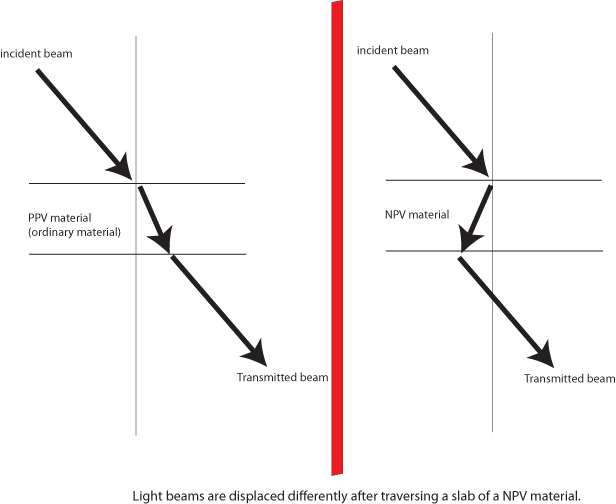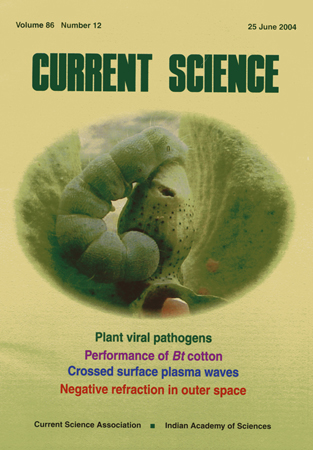Bending Light the "Wrong" Way
Bending light the wrong way
Scientist goes round the bend in optics coup
Bending Light the 'Wrong' Way: Study Suggests Simple Way To Make Near-perfect Lenses
Bending Light the 'Wrong' Way
Study suggests simple way to make near-perfect lenses
Bending light the 'wrong' way could result in near perfection
Study suggests simple way to make near-perfect lenses
Portuguese
Spanish
In plane focus
Making Optical Lenses Better and Cheaper
Optics theory may yield low-cost, near-perfect lenses
Dust mix could negatively refract light
Could Simple Mixed Materials Make Flat Lenses Cheap?
Twinkle, Twinkle Little Star, How I Wonder Where You Are
Star Locations are Uncertain
The discovery of isotropic, homogeneous, dielectric--magnetic materials that bend light the "wrong way" created quite a stir in 2001; see the following figure. The situation settled in 2003, with unequivocal demonstrations by several independent groups. A range of exotic and potentially useful phenomenons -- such as negative refraction, negative Doppler shift and inverse Cerenkov radiation -- have been predicted for materials of this type. We call these as negative-phase-velocity (NPV) materials, but at least two other names have common currency too: left-handed materials, and negative-index materials.

Perhaps the potentially most useful application of NPV materials is for the so-called perfect lenses. Once satisfactorily designed and fabricated, such lenses could find widespread use in modern optics, for communications, entertainment, and data storage and retrieval. More uses would emerge with ongoing research on anisotropic NPV materials.
Instead of concentrating on devices, and inspired by the centenary next year of Einstein's postulation of the special theory of relativity (STR), we turned our attention to the marriage of the theories of relativity and NPV light propagation. We found, a few months ago, that materials that appear to be of the non-NPV type to relatively stationary observers can appear to be of the NPV type to observers moving with uniform velocity. That result permitted us to envisage STR negative refraction being exploited in astronomical scenarios such as, for example, in the remote sensing of planetary and asteroidal surfaces from space stations. Quite possibly, space telemetry technologies will be the first to reap the benefits of STR negative refraction. Application to remotely guided, extraterrestrial mining and manufacturing industries can also be envisioned. Furthermore, many unusual astronomical phenomenons would be discovered and/or explained via STR negative refraction to interpret data collected via telescopes.
Ordinary vacuum (i.e., matter-free space) appears the same to all observers moving at constant relative velocities. Therefore, NPV propagation in vacuum cannot be observed by such observers. This could lead one to believe that NPV propagation is impossible in huge expanses of interstellar space. However, gravitational fields from nearby massive objects will certainly distort electromagnetic propagation, which is a principal tenet of the general theory of relativity (GTR) and is indeed used nowadays in GPS technology.
We have now mathematically established that gravitationally affected vacuum can support NPV propagation in some directions, at least in spacetime manifolds of limited extent.
Just as scientific and technological applications of STR negative refraction (by materials) have been envisaged, similar and different consequences of gravitationally assisted negative refraction by vacuum are possible. Thus, the potentiality for application to space telemetry and remotely guided extraterrestrial manufacturing has been strengthened. Furthermore, our result suggests the possibility of extensive revision of current ideas on the distribution of mass in the as-observed universe, and could affect research on gravitational lensing. We conjecture that this may be of importance in locating hidden matter in our universe.
Reference: Preprint physics/0408021
Acknowledgements: We thank Ms. Stacey Crockett and Kristi Kelso of SPIE, and Drs. Martin W. McCall (Imperial College London) and Graeme Dewar (University of North Dakota), for giving us this opportunity to present our findings.
Presentation: Power Point
Authors: A. Lakhtakia and T.G. Mackay
Study sheds new light on true position of stars at edge of universe
City experts throw new light on location of stars
Black holes bend light the 'wrong' way
Japanese
Greek
Black holes bend light the wrong way
Lithuanian
Bahasa Indonesia
Italian
Black Holes Influence Knowledge of the Universe
Black Holes Influence Knowledge of the Universe
Russian
Chinese
Danish
Hungarian
Spanish
Black holes may reveal much about universe
Illusions of a starry, starry night
Negative Refraction Might be Distorting our View of the Universe
Sag mir, wo die Sterne wirklich stehen!
Vietnamese
| Negative phase velocity in outer space: | T.G. Mackay and A. Lakhtakia, 'Negative refraction in outer space?,' Current Science, Vol. 86, 2004, p. 1593. | Download Preprint physics/0405103 | Negative refraction by vacuum: | A. Lakhtakia and T.G. Mackay, 'Towards gravitationally assisted negative refraction of light by vacuum,' Journal of Physics A: Mathematical and General, Vol. 37, 2004, pp. L505-L510 & 12093. | Download Preprint physics/0408021 |
